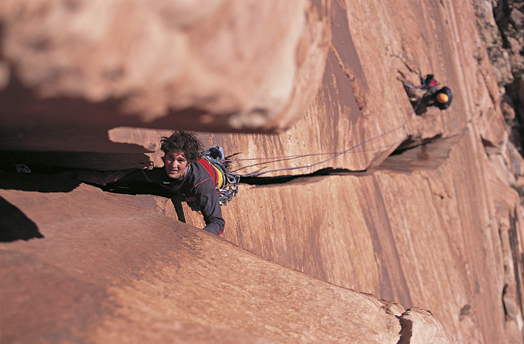The e-mail came to me in Spain:
“Dear Cedar, I’m so sorry, we’ve had so many amazing times, and you’re
my best friend, and I’ll always love you, but I just can’t sit here
waiting for you anymore.” I didn’t have to read any further. My face
turned pale. “I’ve just been dumped by e-mail,” I moaned.

Renan Ozturk peers into the maw of the matter on Free Lhasa (5.12a R, 1,200′), Mt. Kinesava, Zion National Park, Utah. Free Lhasa includes extensive variations to the 1990 Anker-Quinn route Lhasa (V 5.11 A0, 1,200′), including the 500-foot offwidth (“Tatonka Nuck”) in the headwall cracks shown here. [Photo] Eric Draper
Soon I was back in the country, homeless and girlfriendless. Still, I
had faith that somehow, things would work out. My good friend and
climbing partner Renan Ozturk has equal amounts of motivation, passion
and free time for climbing, and he was up for “any type of road trip as
long as it entails adventure and going big.”
We raced impulsively toward Zion. Our timing was excellent: the winter
weather had warmed. A repeat free ascent of the legendary Wind, Sand and
Stars went surprisingly smoothly. The descent, however, did not. Without
a topo and unable to locate the rappels, we endured a
character-building, open winter bivy at 8,000 feet on the summit of
Pariah Point. Since sleep was impossible, we talked over and over about
the route instead: the crazy stemming, the insane, overhanging blobs,
the two-pitch, off-route 5.10 variation with A5 protection to avoid a
5.9, and on and on.
A few days later I ran into my friend Eric Draper at the Bit and Spur.
He offered to drive us through the park the next day to have a look at
potential new free lines. We ended the day at the base of the
world-famous Monkey Finger, theorizing on the potential of a new free
climb that would follow an improbable ramp system to a dihedral to a
roof splitter some 600 feet above the valley floor.
Everything turned out to be harder and steeper than Renan and I had
expected. At one point my left hand crimp suddenly exploded and I reeled
onto my right. A second later my right foothold snapped. I shock-loaded
my right crimp, fighting with everything I had not to fall onto the
string of junk protection below, then shook my way through the rest of
the lead, overdosed on adrenaline.
We reached the roof at last light; Renan pulled on sketchy RURPs over
the lip. Night fell and I barely followed the pitch by headlamp. On top,
I collapsed in the fetal position right in a cactus. I spent the next
several days pulling out the spines. Our route, The Monkeys Always Send,
was something like 5.12a C2 or 12c R/X with every pitch yielding
dangerous “maybe there should be bolts here?” climbing.
After a few days our confidence rebuilt, and Eric convinced us that
Lhasa, a 1,300-foot Conrad Anker and Brad Quinn route on the proudest
face of Mt. Kinesava, would go. On the first pitch, as I groped rotten,
sand-infested slopers, I desperately tried to mantel, and then found
myself airborne, praying that the cams I had stuffed in the rotten flake
below me would hold. Luck was with me, and I survived the fall. A little
creative protection work and I managed the first pendulum free, then
continued into a body-length hand-and-fist crack through a roof. Renan
led the next pitch, which entailed an improbable tunnel-through to avoid
blank rock followed by a rattly finger crack in a corner. We reached the
headwall and realized with horror that the next 400 or more feet
appeared to be a steep offwidth capped by a roof. I ran out 200 feet of
a four-inch crack with only one piece and at the end of my rope found a
perfect natural belay on a small ledge. The unluck of the draw gave
Renan the physical crux: 150 feet of hand-stacking topped by the 12a
offwidth roof. For hours he oozed upward, leaving a sluglike trail of
blood with every move. Several times he almost fell, but then just
fought harder. There’s no real beta for this kind of thing except “fight
for your life” beta. The Free Lhasa (5.12a R) entails extensive
variations to the original route, among them the 500-foot offwidth,
which we named “Tatonka Nuck.”
On March 16 (my birthday), we established a soon-to-be classic new free
route on the East Temple. The route is the most challenging of our
trifecta; we were almost shut down by the crux pitch, which took me
nearly four hours of work before I (barely) eeked out a red-circle
ascent. We called the route The Birthday Bash (V 5.12c/d R, 1,200′)
because I took a huge whipper and gobied my forehead a bit. As of this
writing, Renan and I are still in Zion scoping for more new lines that
we can climb in our preferred style: onsight, free and in a day.
Cedar Wright, Tolhouse, California